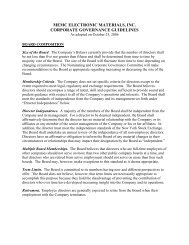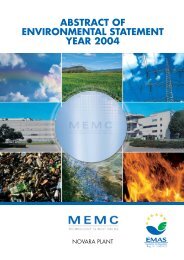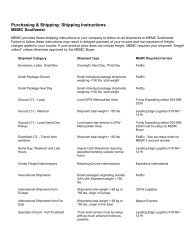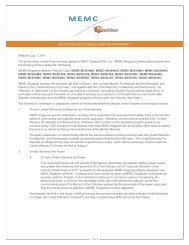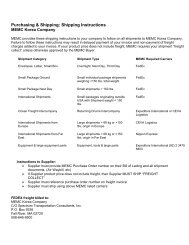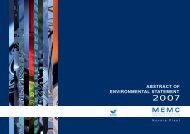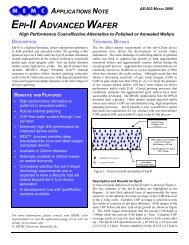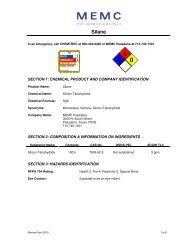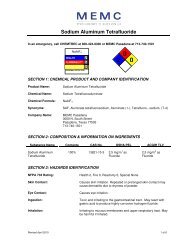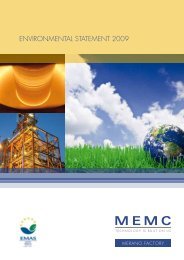BUILDING ON THE PAST, READY FOR THE FUTURE: - MEMC
BUILDING ON THE PAST, READY FOR THE FUTURE: - MEMC
BUILDING ON THE PAST, READY FOR THE FUTURE: - MEMC
You also want an ePaper? Increase the reach of your titles
YUMPU automatically turns print PDFs into web optimized ePapers that Google loves.
18<br />
in hiS oWn WorDS: Dr. roberT WAlSh<br />
on CheMiCAl MeChAniCAl PoliShing<br />
“When we started out, there was no<br />
integrated circuit industry. All the wafers that<br />
Monsanto was selling were just lapped wafers<br />
or etched wafers that went into devices—one<br />
wafer, one device. They were trying to make<br />
these multiple circuits on a wafer and the<br />
photographic process they used required very<br />
flat surfaces. You can’t get that with etching<br />
alone. They needed the wafers to be nicely<br />
polished, and then epi grown on the surface.<br />
The normal polishing techniques used very<br />
fine abrasives but no matter how fine an<br />
abrasive you use, you damage the surface<br />
of the crystal. You couldn’t see them in the<br />
substrate, but when they grew the layer,<br />
they’d show up. Growing an epi layer is a<br />
very serious test of how good a surface you<br />
have. we couldn’t get satisfactory yields and<br />
surfaces with the old polishing method. we<br />
had to come up with something new.<br />
“The early machines were optical polishing<br />
machines. what we found was (we were<br />
running with the finest aluminum oxide you<br />
could buy), that if you kept polishing with<br />
that same suspension of aluminum oxide, if<br />
you kept going, eventually you’d get much<br />
better surfaces on the wafers. At first we<br />
attributed it to wearing down the particle<br />
size even further until it was fine enough.<br />
Then I realized that what it really was, was<br />
that we were adding silicon to the polishing<br />
solution. These machines would fling the<br />
polishing solution off the edge and it would<br />
go down and be pumped back up so we<br />
were actually adding silicon to the polishing<br />
solution. So, thinking about all that, I<br />
thought, ‘Monsanto makes a product that’s a<br />
colloidal silicon.’ So we tried it one day and<br />
it just worked like a charm. It was in water,<br />
too, but it was alkaline. we needed it to be<br />
alkaline to keep it in suspension. The minute<br />
we hit that, the epi yields went up. And as<br />
Dr. Robert walsh developed the chemical-mechanical<br />
process for polishing wafers and received a North<br />
America SEMI Award for his work in 1986.<br />
soon as we saw that all the scratches went<br />
away on the epi surface, we knew we had<br />
something. Basically, that polishing process is<br />
what made integrated circuits possible.”<br />
when asked how it felt to be such a wellknown<br />
pioneer in the silicon wafer industry,<br />
Bob modestly replies, “Well, it’s nice,”<br />
though he received the SEMI Award of North<br />
America in 1986, an award established in<br />
1979 “to recognize outstanding technical<br />
achievement and meritorious contribution” to<br />
the industry. He recalls those early years as<br />
“the fun years,” saying, “It seemed like every<br />
day there was a new challenge to tackle.”



